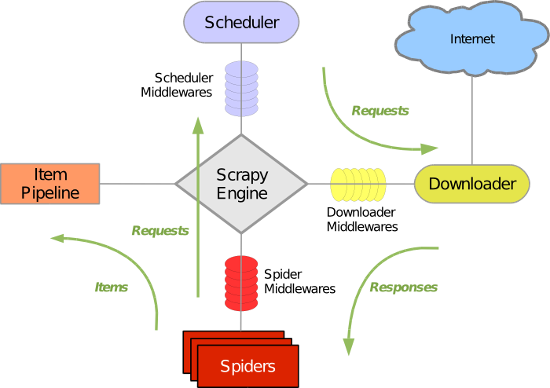scrapy框架的使用
scrapy简介
Scrapy 使用了 Twisted异步网络库来处理网络通讯。整体架构大致如下

Scrapy主要包括了以下组件:
- 引擎(Scrapy)
用来处理整个系统的数据流处理, 触发事务(框架核心) - 调度器(Scheduler)
用来接受引擎发过来的请求, 压入队列中, 并在引擎再次请求的时候返回. 可以想像成一个URL(抓取网页的网址或者说是链接)的优先队列, 由它来决定下一个要抓取的网址是什么, 同时去除重复的网址 - 下载器(Downloader)
用于下载网页内容, 并将网页内容返回给蜘蛛(Scrapy下载器是建立在twisted这个高效的异步模型上的) - 爬虫(Spiders)
爬虫是主要干活的, 用于从特定的网页中提取自己需要的信息, 即所谓的实体(Item)。用户也可以从中提取出链接,让Scrapy继续抓取下一个页面 - 项目管道(Pipeline)
负责处理爬虫从网页中抽取的实体,主要的功能是持久化实体、验证实体的有效性、清除不需要的信息。当页面被爬虫解析后,将被发送到项目管道,并经过几个特定的次序处理数据。 - 下载器中间件(Downloader Middlewares)
位于Scrapy引擎和下载器之间的框架,主要是处理Scrapy引擎与下载器之间的请求及响应。 - 爬虫中间件(Spider Middlewares)
介于Scrapy引擎和爬虫之间的框架,主要工作是处理蜘蛛的响应输入和请求输出。 - 调度中间件(Scheduler Middewares)
介于Scrapy引擎和调度之间的中间件,从Scrapy引擎发送到调度的请求和响应。
Scrapy运行流程大概如下:
- 引擎从调度器中取出一个链接(URL)用于接下来的抓取
- 引擎把URL封装成一个请求(Request)传给下载器
- 下载器把资源下载下来,并封装成应答包(Response)
- 爬虫解析Response
- 解析出实体(Item),则交给实体管道进行进一步的处理
- 解析出的是链接(URL),则把URL交给调度器等待抓取
安装
Linux下的安装(包括mac)
pip install scrapy
Windows下的安装
http://www.lfd.uci.edu/~gohlke/pythonlibs/#twisted
b. 安装wheel
pip3 install wheel
c. 安装twisted
进入下载目录,执行 pip3 install Twisted‑18.7.0‑cp36‑cp36m‑win_amd64.whld. 安装pywin32
pip3 install pywin32
e. 安装scrapy
pip3 install scrapy
基本命令
1. scrapy startproject 项目名称
- 在当前目录中创建一个项目文件(类似于Django)
2. scrapy genspider [-t template] <name> <domain>
- 创建爬虫应用
如:
scrapy gensipider -t basic oldboy oldboy.com
scrapy gensipider -t xmlfeed autohome autohome.com.cn
PS:
查看所有命令:scrapy gensipider -l
查看模板命令:scrapy gensipider -d 模板名称
3. scrapy list
- 展示爬虫应用列表
4. scrapy crawl 爬虫应用名称
- 运行单独爬虫应用
备注:scrapy crawl 应用名称 表示以日志的形式运行爬虫应用,可以在后面加 --nolog 取消日志 scrapy crawl 名称 --nolog
项目结构以及爬虫应用简介
|
1
2
3
4
5
6
7
8
9
10
11
12
|
project_name/ scrapy.cfg project_name/ __init__.py items.py middlewares.py
pipelines.py settings.py spiders/ __init__.py 爬虫1.py 爬虫2.py 爬虫3.py |
文件说明:
- scrapy.cfg 项目的主配置信息。(真正爬虫相关的配置信息在settings.py文件中)
- items.py 设置数据存储模板,用于结构化数据,如:Django的Model
- pipelines 数据处理行为,如:一般结构化的数据持久化
- settings.py 配置文件,如:递归的层数、并发数,延迟下载等
- spiders 爬虫目录,如:创建文件,编写爬虫规则
注意:一般创建爬虫文件时,以网站域名命名
import sys,io sys.stdout=io.TextIOWrapper(sys.stdout.buffer,encoding='gb18030')

import scrapy class ChoutiSpider(scrapy.Spider): name = 'chouti' allowed_domains = ['chouti.com'] start_urls = ['https://dig.chouti.com/'] def parse(self, response): pass

在爬取数据时,可以选择是否往.../robots.txt/发送验证,是否允许爬取,一般设置为False

使用scrapy解析文本内容时,可以使用每个应用中的response.xpath(xxx) 进行数据的解析。
Selector对象。selector对象可以继续xpath进行数据的解析。1.//+标签 表示从全局的子子孙孙中查找标签
response = HtmlResponse(url='http://example.com', body=html,encoding='utf-8') hxs = HtmlXPathSelector(response) print(hxs) # selector对象 hxs = Selector(response=response).xpath('//a') print(hxs) #查找所有的a标签 hxs = Selector(response=response).xpath('//a[2]') print(hxs) #查找某一个具体的a标签 取第三个a标签 hxs = Selector(response=response).xpath('//a[@id]') print(hxs) #查找所有含有id属性的a标签 hxs = Selector(response=response).xpath('//a[@id="i1"]') print(hxs) # 查找含有id=“i1”的a标签 # hxs = Selector(response=response).xpath('//a[@href="link.html"][@id="i1"]') # print(hxs) # 查找含有href=‘xxx’并且id=‘xxx’的a标签 # hxs = Selector(response=response).xpath('//a[contains(@href, "link")]') # print(hxs) # 查找 href属性值中包含有‘link’的a标签 # hxs = Selector(response=response).xpath('//a[starts-with(@href, "link")]') # print(hxs) # 查找 href属性值以‘link’开始的a标签 # hxs = Selector(response=response).xpath('//a[re:test(@id, "i\d+")]') # print(hxs) # 正则匹配的用法 匹配id属性的值为数字的a标签 # hxs = Selector(response=response).xpath('//a[re:test(@id, "i\d+")]/text()').extract() # print(hxs) # 匹配id属性的值为数字的a标签的文本内容 # hxs = Selector(response=response).xpath('//a[re:test(@id, "i\d+")]/@href').extract() # print(hxs) #匹配id属性的值为数字的a标签的href属性值 # hxs = Selector(response=response).xpath('/html/body/ul/li/a/@href').extract() # print(hxs) # hxs = Selector(response=response).xpath('//body/ul/li/a/@href').extract_first() # print(hxs) # ul_list = Selector(response=response).xpath('//body/ul/li') # for item in ul_list: # v = item.xpath('./a/span') # # 或 # # v = item.xpath('a/span') # # 或 # # v = item.xpath('*/a/span') # print(v)
scrapy的持久化
scrapy的持久化过程分为四个部分
首先,items定义传输的格式,其次,在爬虫应用中yield这个item对象,pipeline收到yield的item对象,进行持久化操作,这个过程中,settings中要进行相应的配置
items.py
# 规范持久化的格式 import scrapy class MyspiderItem(scrapy.Item): # define the fields for your item here like: # name = scrapy.Field() url=scrapy.Field()
爬虫应用
import scrapy from myspider.items import MyspiderItem class ChoutiSpider(scrapy.Spider): name = 'chouti' allowed_domains = ['chouti.com'] start_urls = ['https://dig.chouti.com/'] def parse(self, response): # print(response.text) a_list = response.xpath('//div[@id="content-list"]//div[@class="part1"]/a[@class="show-content color-chag"]/@href').extract() for url in a_list: yield MyspiderItem(url=url)
pipelines.py
class MyspiderPipeline(object): def __init__(self,file_path): self.f = None self.file_path = file_path @classmethod def from_crawler(cls,crawler): ''' 执行pipeline类时,会先去类中找from_crawler的方法, 如果有,则先执行此方法,并且返回一个当前类的对象, 如果没有,则直接执行初始化方法 :param crawler: :return: ''' # 可以进行一些初始化之前的处理,比如:文件的路径配置到settings文件中,方便后期的更改。 file_path = crawler.settings.get('PACHONG_FILE_PATH') return cls(file_path) def open_spider(self,spider): ''' 爬虫开始时被调用 :param spider: :return: ''' self.f = open(self.file_path,'w',encoding='utf8') def process_item(self, item, spider): ''' 执行持久化的逻辑操作 :param item: 爬虫yield过来的item对象 (一个字典) :param spider: 爬虫对象 :return: ''' self.f.write(item['url']+'\n') self.f.flush() #将写入到内存的文件强刷到文件中,防止夯住,不使用此方法会夯住 return item def close_spider(self,spider): ''' 爬虫结束时调用 :param spider: :return: ''' self.f.close()
备注:执行pipeline时,会先找from_crawler方法,这个方法中,我们可以设置一些settings文件中的配置,通过crawler.settings得到一个settings对象(配置文件对象) <scrapy.settings.Settings object at 0x000002525581F908>
执行pipeline中的process_item() 方法进行数据的持久化处理时,如果有多个pipeline(比如:将数据分别写入文件和数据库)时,先执行的pipeline(按照配置文件中数值的大小顺序执行),必须返回一个item对象,否则,后续的pipeline执行时,接收的item为None,无法进行数据的持久化操作,如果只是单纯的对某些数据进行一个持久化的处理,可以通过抛出异常,来阻止当前item对象后续的pipeline执行。抛出异常为:from scrapy.exceptions import DropItem 直接 raise DropItem()
return不返回item对象与抛异常的区别:无返回值或者返回值为None时,后续的pipeline会执行,只是,此时的item为None,而抛出异常,会跳过当前对象后续的pipeline,执行下一个item对象。
settings.py
ITEM_PIPELINES = {
'myspider.pipelines.MyspiderPipeline': 300,
'xxxxx.pipelines.FilePipeline': 400,
} # 每行后面的整型值,确定了他们运行的顺序,item按数字从低到高的顺序,通过pipeline,通常将这些数字定义在0-1000范围内。
备注:数值小的先执行。
获取所有页面
import scrapy from myspider.items import MyspiderItem from scrapy.http import Request class ChoutiSpider(scrapy.Spider): name = 'chouti' allowed_domains = ['chouti.com'] start_urls = ['https://dig.chouti.com/'] def parse(self, response): a_list = response.xpath('//div[@id="content-list"]//div[@class="part1"]/a[@class="show-content color-chag"]/@href').extract() for url in a_list: yield MyspiderItem(url=url) # 获取分页的url url_list = response.xpath('//div[@id="dig_lcpage"]//a/@href').extract() for url in url_list: url = 'https://dig.chouti.com%s'%url yield Request(url=url,callback=self.parse)
备注:通过yield 每一个request对象,将所有的页面url添加到调度器中。
scrapy框架会默认的将所有的结果进行去重操作。如果不去重,可以在request参数中,设置 dont_filter=True
class Spider(object_ref):
def start_requests(self): cls = self.__class__ if method_is_overridden(cls, Spider, 'make_requests_from_url'): warnings.warn( "Spider.make_requests_from_url method is deprecated; it " "won't be called in future Scrapy releases. Please " "override Spider.start_requests method instead (see %s.%s)." % ( cls.__module__, cls.__name__ ), ) for url in self.start_urls: yield self.make_requests_from_url(url) else: for url in self.start_urls: yield Request(url, dont_filter=True)
备注:在执行爬虫应用时,会先执行start_requests方法,所以我们可以重写此方法自定制。
获取响应数据中的cookie
返回的response中,无法通过 .cookies 获取cookie,只能通过从响应头中获取,但是获取的结果还得需要解析。
{b'Server': [b'Tengine'], b'Content-Type': [b'text/html; charset=UTF-8'], b'Date': [
b'Fri, 20 Jul 2018 13:43:42 GMT'], b'Cache-Control': [b'private'], b'Content-Language': [b'en'],
b'Set-Cookie': [b'gpsd=5b05bcae8c6f4a273a53addfc8bbff22; domain=chouti.com; path=/; expires=Sun,
19-Aug-2018 13:43:42 GMT', b'JSESSIONID=aaadbrXmU-Jh2_kvbaysw; path=/'], b'Vary': [b'Accept-Encoding'],
b'Via': [b'cache15.l2nu29-1[69,0], kunlun9.cn125[73,0]'], b'Timing-Allow-Origin': [b'*'],
b'Eagleid': [b'6a78b50915320942226762320e']}
所以,要通过scrapy封装的方法,将cookie解析出来
import scrapy from scrapy.http.cookies import CookieJar class ChoutiSpider(scrapy.Spider): name = 'chouti' allowed_domains = ['chouti.com'] start_urls = ['https://dig.chouti.com/'] cookie_dict = {} def parse(self, response): cookie_jar = CookieJar() cookie_jar.extract_cookies(response,response.request) for k, v in cookie_jar._cookies.items(): for i, j in v.items(): for m, n in j.items(): self.cookie_dict[m] = n.value print(self.cookie_dict)
备注:CookieJar中封装的内容特别丰富,print(cookie_jar._cookies) 包含很多
{'.chouti.com': {'/': {'gpsd': Cookie(version=0, name='gpsd', value='fcb9b9da7aaede0176d2a88cde8b6adb',
port=None, port_specified=False, domain='.chouti.com', domain_specified=True, domain_initial_dot=False,
path='/', path_specified=True, secure=False, expires=1534688487, discard=False, comment=None,
comment_url=None, rest={}, rfc2109=False)}}, 'dig.chouti.com': {'/': {'JSESSIONID':
Cookie(version=0, name='JSESSIONID', value='aaa4GWMivXwJf6ygMaysw', port=None, port_specified=False,
domain='dig.chouti.com', domain_specified=False, domain_initial_dot=False, path='/',
path_specified=True, secure=False, expires=None, discard=True, comment=None, comment_url=None, rest={},
rfc2109=False)}}}
自动登录抽屉并点赞和取消赞代码示例

import scrapy from scrapy.http.response.html import HtmlResponse # import sys,os,io # sys.stdout=io.TextIOWrapper(sys.stdout.buffer,encoding='gb18030') from ..items import XzxItem from scrapy.http import Request from scrapy.http.cookies import CookieJar class ChoutiSpider(scrapy.Spider): name = 'chouti' allowed_domains = ['chouti.com'] start_urls = ['https://dig.chouti.com/r/ask/hot/1'] cookie_dict = {} def start_requests(self): for url in self.start_urls: yield Request(url=url,callback=self.parse) def parse(self, response): # 1. 去第一次访问页面中获取cookie # print(response.headers['Set-Cookie'],type(response.headers['Set-Cookie'])) cookie_jar = CookieJar() # 空 cookie_jar.extract_cookies(response, response.request) # cookie_jar中包含了cookie for k, v in cookie_jar._cookies.items(): for i, j in v.items(): for m, n in j.items(): self.cookie_dict[m] = n.value # 2. 向https://dig.chouti.com/login发送POST请求 yield Request( url='https://dig.chouti.com/login', method='POST', body="phone=8615901492719&password=qwer1234&oneMonth=1", cookies=self.cookie_dict, headers={ 'user-agent':'Mozilla/5.0 (Windows NT 6.1; WOW64) AppleWebKit/537.36 (KHTML, like Gecko) Chrome/67.0.3396.99 Safari/537.36', 'content-type':'application/x-www-form-urlencoded; charset=UTF-8', }, callback=self.check_login ) def check_login(self,response): print(response.text) yield Request(url='https://dig.chouti.com/',callback=self.index) def index(self,response): news_id_list = response.xpath('//div[@id="content-list"]//div[@class="part2"]/@share-linkid').extract() for news_id in news_id_list: # 赞 """ news_url = "https://dig.chouti.com/link/vote?linksId=%s" %(news_id,) yield Request( url=news_url, method='POST', cookies=self.cookie_dict, callback=self.output ) """ # 取消赞 news_url = "https://dig.chouti.com/vote/cancel/vote.do" yield Request( url=news_url, method='POST', body="linksId=%s" %(news_id,), cookies=self.cookie_dict, headers={ 'content-type': 'application/x-www-form-urlencoded; charset=UTF-8', }, callback=self.output ) # 2.1 获取页面 page_list = response.xpath('//*[@id="dig_lcpage"]//a/@href').extract() for url in page_list: url = "https://dig.chouti.com" + url yield Request(url=url,callback=self.index) def output(self,response): print(response.text)
备注:爬取过程中的坑:请求头中,一定要携带content-type参数。请求过程中的url不能重复,尤其是和起始url。
from urllib.parse import urlencode ret = {'name':'xxx','age':18} print(urlencode(ret))
作者:赵盼盼
出处:https://www.cnblogs.com/zhaopanpan/
本文版权归作者和博客园共有,欢迎转载,但未经作者同意必须保留此段声明,且在文章页面明显位置给出原文连接,否则保留追究法律责任的权利。
⇩ 关注或点个喜欢就行 ^_^
关注我






